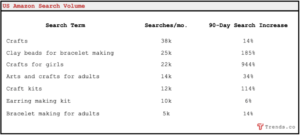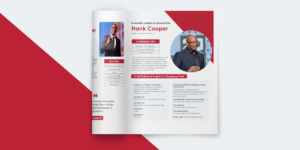In March, Visa announced that Frank Cooper III will join the company as Chief Marketing Officer (CMO) starting in May. He will also serve as a member of the company’s Executive Committee and report to Chairman and Chief Executive Officer (CEO), Al Kelly.
New CMO’s are always a prime new business opportunity for agencies, typically considering new partners within the first 6-months.
In this guide, you will learn everything you need to know about Frank to develop meaningful outreach. Including:
- Work history
- News highlights
- Speaking engagements
- Personality insights
- Outreach tips
One of the metrics agencies tend to obsess over the most is conversion rate. It’s easy enough to calculate: take the number of prospects your agency pitches and divide it by the number that actually become clients. Multiplied by 100, this is your conversion rate.
What agencies are really examining through this number is all the work that goes into converting prospects into clients. ‘Are we listening to the client enough? Are we focusing properly on the problem they want to solve? Are we presenting our team as the right fit for the client, as much as our ideas?’ If your agency’s conversion rate is lower than you’d like it to be, the cause likely falls under one of two reasons:
- Your marketing process is not qualifying leads properly. The best agencies are just as selective about the clients they pitch to as clients are about who they work with. Know your strengths and only pitch to clients whose needs offer the chance to flex those strengths in full capacity.
- Your new business process isn’t resonating with prospective clients. You might be a great fit for a client’s needs, but you’re not conveying your capabilities in a language they understand. In some cases, clients may understand your technical terminology well enough, but a sense of arrogance or complexity of it turns them off.
If you suspect your agency conversion rate is suffering from a disconnect in your new business process, examine the language you use in your pitch deck. Let’s review the eight types of language you should immediately remove to become a more approachable, relatable team your ideal client will want to work with.
What is jargon?
According to the Plain Language Action and Information Network (PLAIN), a working group of U.S. federal employees who support the use of clear communication in government writing, jargon is “unnecessarily complicated language used to impress, rather than to inform, your audience.”
Jargon is not technical language that you must use to convey a concept or stay within legal guidelines. It’s the difference between saying, “Our manifold aptitudes position our robust assembly of employees as the most qualified advertising business organization for the purpose of promoting your product or service presently being discussed” versus (in plain language a client will actually understand), “Our team’s strengths make us the right agency for your campaign.”
PLAIN identifies three types of jargon to watch out for:
- Technical jargon: It’s fine to use the proper term for a concept or object when necessary, even if the term is long or uncommon. But it’s possible to use plain language around that technical term so that you don’t cause confusion or misunderstanding around it.
- Legal jargon: Even when composing a legal document, it’s best to avoid using archaic words in favor of more informal language with the same meaning. Heretofore, we herewith recommend the abandonment of any and all musty-sounding legal verbiage wherein the meaning is not clear whatsoever and a word with identical denotation is henceforth more acceptable. See what we mean?
- Business jargon: These are words that people use as filler, or when attempting to be seen as savvy or intelligent. Some examples:
- Thinking outside the box
- Value-add
- Best practice
- Touch base
- Circle back
You don’t need these terms when pitching clients: You know their product and you have the ability to execute your ideas. If you wouldn’t use a phrase in conversation with friends, don’t put it in your pitch deck.
8 Overused Terms to Remove From Your Pitch Deck Immediately
The following terms have been used so much for so long in the advertising industry that they’ve lost any meaningful value. If these still appear in your pitch deck, it’s time to get creative and replace them with direct language that makes your point.
1. Full service
Almost every agency claims they’re full-service, but with so many media channels available, it’s tough – if not impossible – for any one agency to truly be able to cover them all. Instead of claiming to be full-service, emphasize your creative and technical strengths.
2. Integrated
This word means that the various parts of a system are linked or coordinated. Every agency is integrated in the sense that its departments or teams work together to bring in new business and deliver on its promised services. So this isn’t a unique claim. Instead of boasting about being an integrated agency, provide examples of the synergies your agency specializes in, and how your internal specializations work together to produce big results.
3. Wide range of services/experience
It’s fine to offer multiple services, especially if you are pitching a larger account. But what potential clients really want is an agency that has experience in their industry and in their desired platforms. Show them you can customize your work to their goals.
4. Customized
Which brings us to the term “customized.” You’re definitely customizing your work for each client, so you don’t need to say that. Explain in detail how you’ll approach their work. A client will remember a stellar example instead of a blanket statement about customization.
5. Strategic
If you weren’t strategic in your work, the client would not be bothering to sit through your pitch deck presentation. Intelligently approaching their problem is a given. Show them the research and critical thinking that went into your proposed solutions instead.
6. Holistic/wholistic
This term is similar to ‘customized’ in that it should be a given that your proposed work will dovetail with the client’s other products, services, and marketing efforts. No one will hire an agency that insists on operating in isolation.
7. Dedicated
While it’s nice to hear that your agency will be dedicated to the client and their advertising needs, they already expect that. This is another area where actions mean more than words: Give examples of how responsive your team can be to a client and their campaigns.
8. Storytelling
This term has been trendy since the rise of Web 2.0 when social media gave everyone a soapbox and a microphone. When everyone is a storyteller, it’s no longer a differentiator. Besides, storytelling isn’t the goal: Increased sales, more revenue, launching a new brand—those are the goals.
Keep It Simple
Increasing your agency’s conversion rates hinges on the big and little things. Clearing your pitch deck of unnecessary jargon is one of those little things with big impact. An effective, memorable pitch speaks in a way your prospective clients will easily understand. It also leaves out a lot of words you might think you need in favor of letting your ideas speak for themselves.
As a recap, to clear your pitch deck of jargon:
- Have multiple team members review it, from senior execs all the way to junior associates, not just the editor.
- Ask a trusted client to review it with an eye to remove terms they don’t quite understand or have heard a thousand times already.
- Consider hiring a search consultant to give their opinion (hint hint).
- Read your slides out loud. It forces you to see and hear exactly how your presentation sounds by immediately placing you in the perspective of the listener.
And most importantly, don’t forget to identify, crystalize and clearly communicate your agency’s passion throughout your pitch deck.
Have you been changing, reinventing or nuancing your creds just to be who you think your clients want you to be? And in that shifting, pivoting and recreating have you lost yourself?
If so, you’re not alone. Some of the best agencies in the world struggle with their messaging.
In this Lesson Session, NBZ Partner’s executive team goes over how to perfect your agency messaging once and for all.
For more information about NBZ Partner, visit their website.
Client requests are becoming increasingly specific with a big emphasis on funnel.
In this quarter’s smAARt Huddle, AAR Partner’s share’s the trend of performance-based agency requests, with the add on of needing to understand brand.
Agency executives chime in on activity levels, budget trends and more.
Learn about what’s happening in Q2 here!
What’s Trending: The craft supply industry buttoned up ~$647B last year and is on track to nearly double by 2026.

Tactile crafts have had a glittering year. Subscribers to r/Embroidery and r/Leathercraft have doubled over the last ~12 months. The woodworking community of Reddit is now 3.5m+ strong.
US Amazon searches for “crafts for adults” are up 83% over the last 90 days, per Jungle Scout. Pinterest is awash with more craft-based interest across Europe, Canada, Australia, and the UK.
The Cause: Being stuck at home zapped our creative juices, and while some lockdown hobbies came and went others — like crafting — have continued to boom.
The global handicrafts market was worth ~$647B in 2020, and is forecast to grow to ~$1.2T by 2026 (an ~11% CAGR).
1) Entry-Level Handicrafts: Simple crafts are in high demand. Examples of US Amazon search volumes:

Excludes Valentine’s and Easter related crafting searches, which are currently exploding. Source: Jungle Scout, January 2022
The market for basic crafting materials is enormous. These 1-inch wooden craft balls generate $1.4m+/mo. on Amazon, and a single brand of acrylic yarn does $730k+/mo., per Jungle Scout.
Entrepreneurs could sell materials D2C, or focus on simple kits; this bracelet-making one brings in $350k+/mo. Why not combine trends? Entry-level crafting ties in with opportunities in sensory art for children.
2) Get Online: The crafting market, which is traditionally brick-and-mortar heavy, is moving online — US ecommerce sales of hobby and crafting supplies hit a record $15B+ in 2021.
Similar to the opportunities uncovered for DIY’s pivot to ecommerce, entrepreneurs could create one-stop online shops for the growing body of crafters.
Niching down (with focus on specific SEO) is a strong opportunity. Similarweb shows this antiquated embroidery supplies site gets ~70k visits/mo., and ~70% of traffic is organic. Imagine the attention a modern, well-branded version would attract.
Crafting is hugely popular on social media, which means you can leverage the trend to advertise your platform or brand (TikTok’s #crafting has 1.8B views).
3) Advanced Crafts: Skills like leatherwork, woodwork, and sewing are in vogue.

Source: Subreddit Stats
One seller of embroidery kits has racked up 55k+ sales on Etsy; a rough median price of $12 puts revenue at ~$660k+.
Other examples of US Amazon 30-day search volumes, via Jungle Scout:
- “Crochet kit” — 37k
- “Jewelry making kit” — 27k
- “Woodcarving kit” — 12k
- “Leather working kit” — 3k
At-home candle-making is also heating up. These soy wax beads generate $1.3m+/mo. on Amazon, and there are 140k monthly searches for “candle making kit.” Options like this one bring in $500k+/mo. (kits for status candles are a solid opportunity).
For all these advanced crafts, entrepreneurs could focus on guides and content: Subreddits are full of “how to” questions (some examples from r/weaving).
You could start a newsletter, blog, or podcast. Don’t underestimate the power of community in these small crafting niches: Spin Off, a publication dedicated to spinners of yarn, has newsletter subscription packages for $35-$180/year and ~90k site visits/mo., per Similarweb.
The “finish it yourself” trend could be big for more challenging crafts. Deliver kits with the basics already done, allowing less experienced consumers to easily partake.
4) Experiences: Events like wine and craft nights are starting to make an impressive resurgence. Searches for “paint night near me” are on the rise again; Pinot’s Palette, with paint night tickets starting at $35, has ~300k site visits/mo. according to Similarweb.

Source: Google Trends
Entrepreneurs could branch out to a variety of group craft experiences, with or without the wine component (but in case you were wondering how versatile the craft + beverage space is, drunk knitting is already a thing on Reddit).
The Opportunity: Get a little crafty with your outreach and start building relationships with brands in this booming crafts category.
Prospect smAARt, pitch with purpose and most importantly, with passion!





